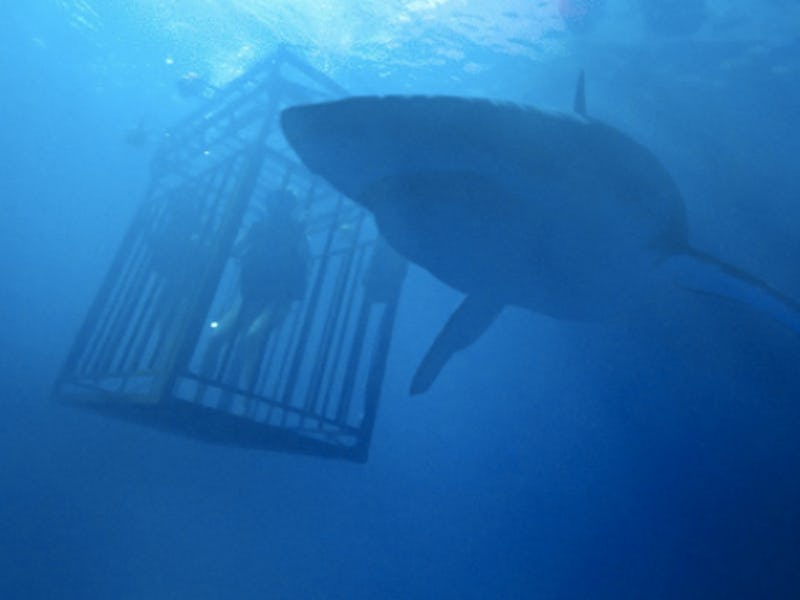The new shark horror film 47 Meters Down follows two sisters who decide to get a little dangerous while on vacation in Mexico, signing up for shark cage diving with the local cuties. It’s all fun in the sun until their hoist breaks, trapping the women in a cage at a dark, shark-filled depth of, yes, 47 meters. From there, the movie becomes a thrilling rumination on the question: What should a person actually do if trapped in a shark cage at the bottom of the seafloor?
Not what happens in the movie, Chris Lowe, Ph.D., tells Inverse. As a professor of marine biology at California State University, Long Beach, and director of the university’s Shark Lab, Lowe knows a lot about sharks. He once dove in the warm, clear waters of Guadalupe Island, the popular Mexican vacation spot where the film loosely takes place. When you’re cave diving there, he says, it’s possible that there could be up to seven white sharks hanging around your cage at any given time — but that doesn’t mean that if your cable breaks, you’re chum.
“These characters are at 47 meters, which is around 155 feet, with a single scuba tank,” says Lowe. “The reality of it is that they are going to run out of air in fifteen minutes, and because they’re panicked, they are breathing harder and faster.”
In the movie, the women are advised to stay in the cage until they’re rescued. But that would be the last thing you’d want to do in real life.
“The number one thing you would do if you’re dropped to that depth is get out of the cage,” says Lowe. “You would slowly inflate the air in that vest so that you could slowly rise through the water column.” A crucial part to this escape plan is the use of buoyancy compensators, which are the vests that strap the air tank to the diver’s body. These can be filled with different amounts of air in order to make the diver more or less buoyant.
But what about the sharks? Lowe admits they can be dangerous — but not as much as we’d think. That’s predominantly because sharks aren’t typically the aggressive, violence-seeking animals pop culture has made them out to be. Even a big white shark is a cautious animal because it doesn’t want to put itself in a situation where it can be injured. And because scuba systems make divers clunky and foreign-looking, most sharks actually try to avoid divers.
Still, you should alert sharks that you’re aware of their existence, says Lowe, who notes that the chances of survival are even better when you’re trapped with a friend. In shark-inhabited waters, it’s best for divers to stay back to back, sticking together, and pivoting and turning as they swim to the surface, so that it’s more likely that the shark will catch someone’s eye.
“You’re always looking around you, keeping your eyes on the shark, because you want the shark to always know you’re watching,” says Lowe. “In most cases, sharks just leave — if their prey can see them, they often won’t approach. If the divers were to stay together, their chances of getting up would be just fine.” The idea that sharks will immediately attack humans is a misperception propagated by scary shark movies. In reality, he says, “99.9 percent of the time that shark is going to check them out, think ‘what the hell is that,’ and then take off.”
Mandy Moore in '47 Meters Down'
Another concern for divers is the possibility of getting “the bends,” or decompression sickness, though Lowe notes that because of the short amount of time the divers have to swim back the surface, this largely wouldn’t be a concern. It’s a phenomenon that happens when a diver surfaces too quickly; the rapidly changing pressure causes dissolved nitrogen in the blood to come out of solution and form bubbles in the diver’s body. The bubbles act like blood clots, raising the risk of pain, artery blockage, and even paralysis.
“If they were dropped to the bottom, and let’s just say they have a full tank when that happened, they would have about fifteen minutes of air before they would run out, at best,” says Lowe. “They wouldn’t be deep long enough to require what we call decompression stops, which allow that nitrogen to come out of your blood and for you to exhale it, so that you wouldn’t get the bends.”
While watching the trailer for the movie gave Lowe “a good chuckle,” he’s concerned that the fear associated with sharks is making it harder to convince people that they need to be protected. Studies show that oceans need sharks to maintain the predator-prey balance, but currently about 100 million sharks are killed every year. Still, Lowe acknowledges that shark horror is here to stay.
“These movies have become so much of our summer culture in America that it’s almost expected,” Lowe says. “I would argue that there’s Fourth of July, there’s apple pie, and then there’s sharks.”
6/23/2017: Additional information has been added to this article.
